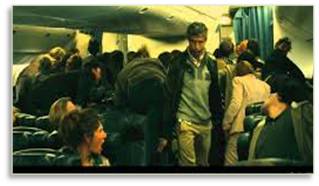In last week’s post about the Middle East Respiratory Syndrome corona virus (MERS CoV), I quoted Brad Pitt in World War Z, who said that airplanes are the perfect transmission medium. Several people have traveled to the Middle East, particularly Saudi Arabia, and then returned home by plane only to fall ill with MERS and transmit it to “a limited number” of people with whom they were in close contact.
If I were writing a novel about a worldwide pandemic, I would create a scenario in which millions of people traveled to the point of origin, contracted the virus, and then returned home via jet plane to spread it in quickly in far parts of the globe. That scenario actually exists and it is scheduled to take place from October 13 to 18 of this year.
It’s called The Hajj.
The Hajj and Corona Virus
In the Hajj, or pilgrimage, devout Muslims travel to the holy cities of Mecca and Medina, as they have every year for 14 centuries, to perform rituals based on those conducted by the Prophet Muhammad during his last visit to the city. The Hajj is the Fifth Pillar of Islam and “the most significant manifestation of Islamic faith and unity.” Undertaking the Hajj at least once in a lifetime is a duty for every able-bodied Muslim who is financially able to make the journey.
The real crowds began arriving in the time of King Abdul Aziz Ibn Abdul Rahman Al-Saud, the founder of the modern Kingdom of Saudi Arabia. He took significant measures to improve the security, well-being and sanitation of the pilgrims.
Still, the sheer numbers of people can create dangerous conditions and, as Murad Kalam reported in Outside magazine, “If It Doesn’t Kill You First,” people sometimes die, especially when moving in crowds from one ritual location to another. The worst such incident occurred in 1990, when a stampede inside a pedestrian tunnel led to the deaths of 1,426 pilgrims.
An Ideal Transmission Medium
During the five days of the Hajj, millions of pilgrims jam together while traveling to and from, in camps, and during the rituals.This creates an ideal transmission medium for a respiratory corona virus. Problems could start even earlier: Ramadan, which begins on July 9, also draws millions of pilgrims for Umrah. Now consider these facts:
- In 2012 the Hajj drew 3.1 million pilgrims to Saudi Arabia.
- Ramadan Umrah drew 6 million people.
- Many of the pilgrims come from poor countries that are unequipped to deal with even ordinary diseases.
- The corona virus’s means of contagion still have not been identified.
- The World Health Organization (WHO) has said MERS CoV can be transmitted from person to person.
- The mortality rate for MERS CoV is currently at 52%, vs. 9% for SARS and 2.5% for the influenza pandemic of 1918-19. This percentage is questionable, however, as the number of people who have fallen ill but not been diagnosed or were asymptomatic is not known.
- October is the beginning of cough, cold and flu season in North America.
Fears and Preventive Steps
 Yesterday Fox News reported on Fears of MERS at Muslim hajj pilgrimage. @WSJ, @CNN, @NYT and other major news outlets have also raised concerns about MERS CoV.
Yesterday Fox News reported on Fears of MERS at Muslim hajj pilgrimage. @WSJ, @CNN, @NYT and other major news outlets have also raised concerns about MERS CoV.
Saudi authorities, aware of the situation have taken steps to prevent or minimize the impact of MERS on Hajj pilgrims. To date, they have:
- Implemented a 15-day limit on visitors performing Umrah.
- Recommend that pilgrims get vaccinated against hepatitis A and B, typhoid, and the seasonal flu before traveling to Saudi Arabia.
- Urged people to observe standard hygiene practices like washing hands, sneezing into a tissue or sleeve, and avoiding sick people. The latter may be difficult, of course, when you’re surrounded by millions of your fellow worshipers.
- Recommended that visitors performing Ramadan Umrah wear masks. Muslim women wearing the niqab are already veiled, of course.
Reducing the Number of Pilgrims
Most importantly, Saudi authorities have cut back foreign pilgrim permits due to expansion work on the Grand Mosque in Mecca. Authorities reduced the number of pilgrims coming from within Saudi Arabia by half, and those from abroad by about 20%. They cut Hajj permits from 10,000 to 8,300. Although many Muslims worldwide are not happy about this, these steps may turn out to be a good thing in the long run.


